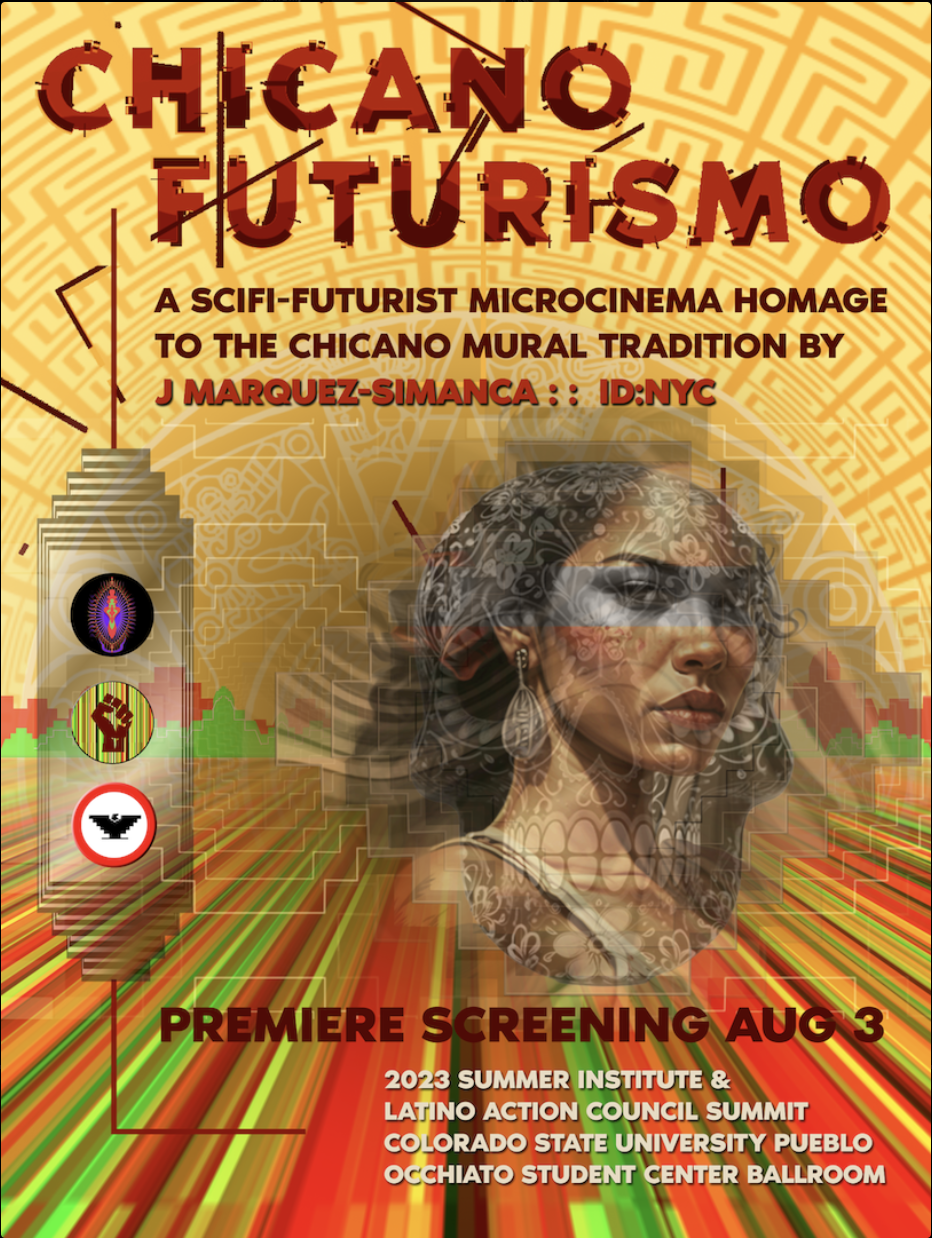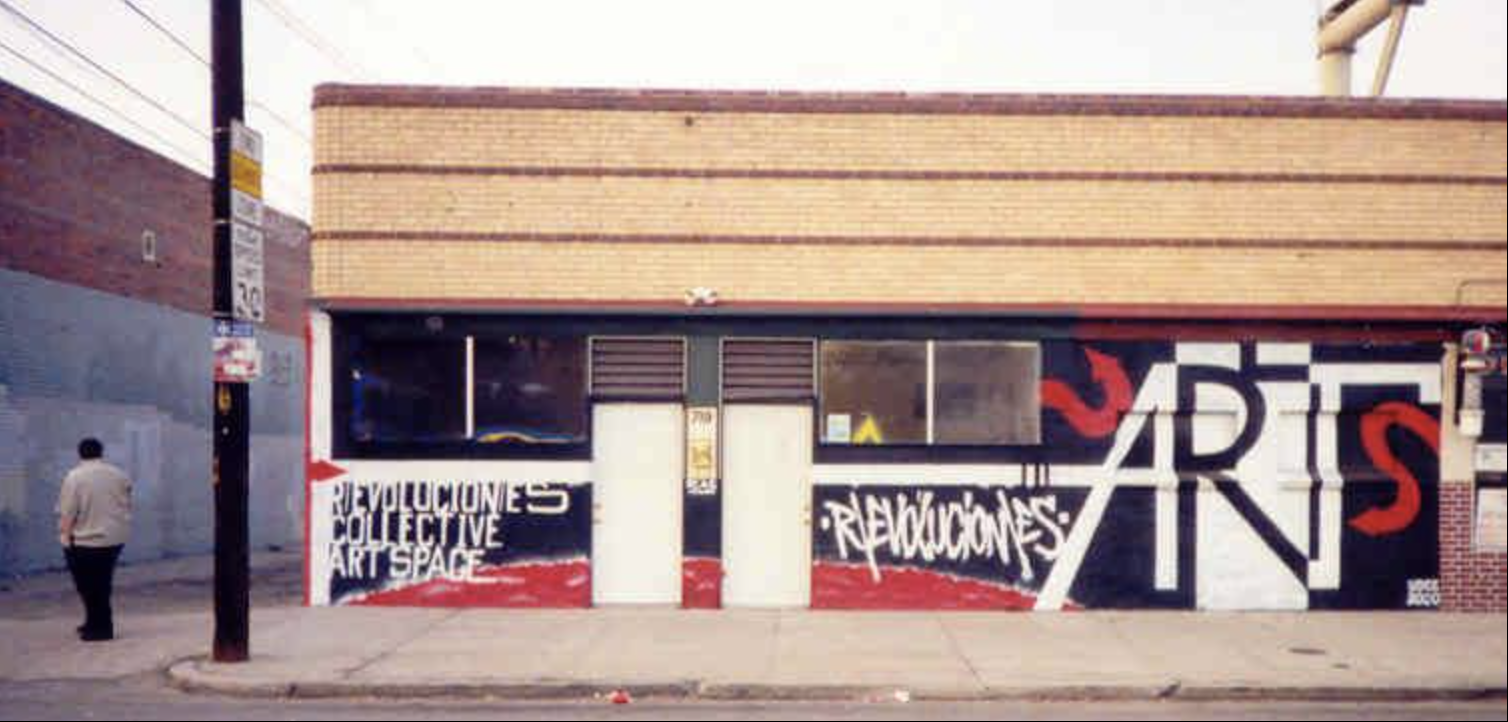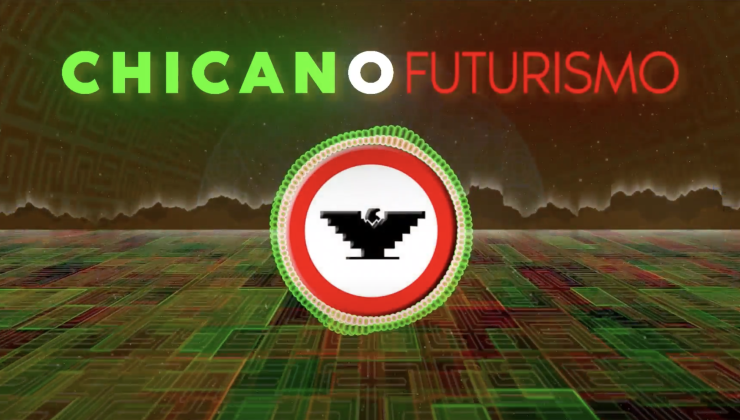Art
November 15, 2023
ChicanoFuturismo: Interview w/ J Marquez-Simanca
Jeremy Marquez-Simanca is a Chicano artist, graphic designer, and illustrator based in New York City, with his roots established in Denver. He co-founded and served as the curator of Revoluciones Collective Art Space, a communal arts warehouse on W. 8th St, that hosted local exhibitions, performance art, experimental music and the celebration of the subculture for the gen-X hip-hop & punk scene in the late 90s and early 2000s.
At the end of Revoluciones, Jeremy moved to New York City where he attended the Fashion Institute of Technology, pursuing his studies in communications and graphic design. His design aesthetic is situated in a modernist approach, with a surrealist and psychedelic language in presentation of his artwork. His recent work, ChicanoFuturismo, is a digital video with the objective to promote Carnalismo - a foundational belief on indigenous values of helping and supporting each other.
I had the opportunity to connect with Jeremy to learn more about his creative ingenuity, both past and present.

Hi Jeremy!
You are no stranger to the Denver arts scene having co-founded and curated Revoluciones Collective Art Space, which was such a cool spot along Santa Fe back in the late 90s early 2000s. Could you share a brief history of the space and what had inspired its establishment?
As a burgeoning artist in the mid 90s, I had a hand in multiple scenes and subcultures. With a large network of creative friends, I wanted to create a forum and a space to showcase our works. I was inspired by “Planet Off“ and “Futra”, two new Denver Gen-X art spaces that opened in the Northside. Taking cues from the Universal Zulu Nation’s Hip-Hop philosophy, and the DIY Punk ethic, I teamed up with a few co-conspirators to convert an old warehouse on the Westside into Revoluciones Collective Art Space. In 1997, amid construction on gallery and studio space—as well as living quarters—in a cold warehouse with no hot water, we immediately began hosting local events.
How do you feel Revoluciones Collective Art Space created a space for local creatives to share and collectively celebrate their artistry with the community?
Beginning monthly in February 1999, Revoluciones was open to the public for First Friday gallery openings, various events throughout the month, and ending with a closing reception. In an open forum of expression, the diversity of artists, styles, and mediums delivered distinct and innovative works and performances on display for and by the community. From street art to fetish photography, dj battles to modernist sculpture, and poetry slams to pirate radio signals, the resonance of the DIY spirit of the Revoluciones community reverberated out to help develop the foundations of the Santa Fe and RINO Art Districts.

Image: Revoluciones Collective Art Space. 719 W 8th Ave Denver CO.
As an artist, your work within graphic design is infused with your cultural lineage. How has this process been in sharing the stories of past and present?
My digital art is informed and structured by my training as a Graphic Designer in a Modernist curriculum, in order to facilitate the communication of my otherwise psychedelic and surreal imagery to my audience. The crucial ideograms and iconography are rooted in concepts that I developed in those days in the mid 90s upon discovering and cultivating my Chicanismo. What began as complex ink-stipple drawings on paper of my visual interpretations of Chicano cultural symbols and motifs, later became the digital illustrations that I now set to kinetic typography and motion graphics with original soundtracks.
My Paternal great-grandparents were Manitos–meztizos from New Mexico–who migrated up to Denver in the 1920s. A large number of their Denver-born offspring were proactive in the city’s Chicano Movement of the late 1960s and 70s. This laid a foundation for me to discover and embrace as a young adult. For myself, the term Chicano is thus a political identity; a radical signifier that is an embrace of the knowledge of our history, in order to unify and organize in the present, towards creating a future of equality for our community.
This year, you unveiled Chicanofuturismo at the 2023 Summer Institute & Latino Action Council Summit at CSU Pueblo. Could you share more about the inspiration behind Chicanofuturismo?
Chicanofuturismo centers on the concept of Aztlán–the mythical northern homeland of the Aztecs–which became the name of the Chicano homeland during the Chicano Movement. In Chicanofuturismo, Aztlán extends into a virtual and conceptual utopian space that nurtures our cultural identity through the dissemination of cultural symbols. Artists, Literary Heroes, and Chicano civil rights leaders are conjured from the past and broadcasted into the Aztlán field via digitized visual information. These information patterns of visual tradition are conveyed through Mesoamerican motifs of mixed Aztec, Maya, and Hopi/Pueblo Patterns, and displayed on retro-futurist video screens. The memories of the Movimientos cultural/spiritual/political ideals are transmitted into Aztlán space, and translated into kinetic typography agit-prop slogans. Cultural and spiritual iconography are revealed through the intersecting patterns of digital-cultural recuerdos from the center of the Aztlán matrix called Sipapu, a portal from which the ancestors emerge into the present world.
Chicanofuturismo’s primary objective is to promote Carnalismo – A brotherhood founded on indigenous values of helping and supporting each other. Libertad and unidad are achieved in the present and future under a unified Chicano identity.
On top of your many talents and creative work, you are also the Art Curator for Monologging.org, a digital magazine that brings artists and writes together, globally. Could you share more about Monologging’s mission and how local artists and writers might become involved?
Monologging.org is an annual online literary magazine and small press. The platform connects writers with artists around the world, prompting collaborative multimedia creations. As the Art Curator of Monologging.org, I feel that my efforts are an extension of what i was doing with Revoluciones twenty years ago; providing an outlet for visual artists to be a part of a global community of creatives, displaying their work on a level that wasn't quite available and accessible back then.
We are currently compiling works for the upcoming issue entitled “Rewilding”, to be released at year's end, and I am now accepting artwork for review that can be submitted to me at info@idesignnyc.com.
Any projects of yours coming up in Denver that we should know about?
I currently have no immediate plans for projects in Denver, as I’m busy working to show my art here in NYC, and hustling for jobs as a freelance Graphic Designer. However, I’m always open to exhibits and additional screenings of my art videos in my hometown. The entire month of April this past year, I exhibited Reciproca - A Motion Graphics Manifesto –a tribute to the Futurist and Constructivist art movements–as a 6500 sq ft digital-mapping projection on the D&F tower in Downtown Denver. The core concepts of mutual aid, mutual support, and volunteer cooperation in the message of Reciproca are presented as radical agitprop, and reflected in what would soon after manifest as the indigenous values expressed in Chicanofuturismo.
As we come to the end of 2023, what are you looking forward to?
In 2024, I’m looking forward to promoting the initial facet of my ongoing magnum opus called Mea Hermetica. This first phase of Mea Hermetica is entitled, Origins, a nine-minute journey through my artistic process of constructing my own Cosmic Diagram. Mea Hermetica: Origins is an hallucinogenic meditation on the emergence and evolution of consciousness, applying additional key visual concepts that I developed in the late 90s. As with my other motion graphics Microcinemas, Origins also features an original accompanying music score that rhythmically carries the visuals towards an immersive audiovisual experience.
